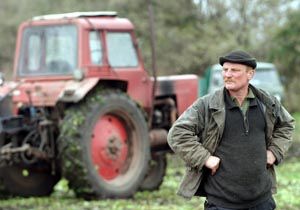Ukrainian state to participate in agricultural insurance
Experts estimate at least 40-50 percent of areas under crops need protection
The Ministry of Agrarian Policy and Foodstuffs (Minahropolityky) intends to establish the State Agricultural Insurance Company (DASK in its Ukranian abbreviation), as laid down in the draft cabinet resolution “Agricultural Insurance System Development Concepts in Ukraine.”
According to this document, a state insurance agent is supposed to act as an insurer, reinsurer, and agricultural insurance manager. Its authors believe that agricultural producers should pay 50 percent of the cost of an insurance policy to the insurance company, with the rest being provided by the central budget. Also, right after signing an insurance contract, the insured can apply to DASK for the remaining 50 percent. After receiving this application, the government-run company forwards the package of the policyholder’s documents to the Minahropolityky. The ministry must make the payment to DASK within a month, whereupon the company pays the insurer. In other words, the policyholder is guaranteed full compensation in case of an accident only after the company receives all the money due it for the insurance policy. Minahropolityky believes this will help improve work between agricultural producers, insurers, and the state.
DASK’s authorized fund requires a million euros from the state budget. The stated concept is to be implemented stage by stage. Stage one is legislative. Stage two is the development and testing of insurance products, generating an agricultural insurance database.
Below are expert comments on DASK’s market prospects and consequences.
COMMENTARIES
Roman SHYNKARENKO, IFC Ukraine Agri-Insurance Development Project consultant on agricultural Insurance:
“The stated model isn’t bad, as this time the ministry has taken into consideration the insurers and consultants’ opinions. The only thing I don’t like is that the insurance contract takes effect only at a level of 50 percent, after making the first payment, and that only 50 percent of the policyholder’s areas under crops will be insured unless the state pays the rest of the money within 30 days. Our organization has proposed that your government set up an agri-bureau made up of insured producers. Even if they decline, there are two models practiced elsewhere in the world. The first is when a government-run agency manages such insurance programs, and the second one, when this is done by the insurers.
“Agricultural insurance costs vary in various regions and in various periods. For example, winter crops (wheat, rye, rape) cost between 50 and 90 hryvnias per hectare. Spring-summer sunflower and corn cost 50-170 hryvnias. In Dnipropetrovsk, Zaporizhia, Kherson, Donetsk, and Luhansk oblasts agricultural insurance policies will be higher by 20-30 percent because these areas have higher insurance risks due to frequent droughts. I believe at least 40-50 percent of the Ukrainian areas under crops should be insured; well, it would be best to insure all of them, of course.
“Strategic crops, i.e. ones that secure adequate food supplies on a national basis — winter wheat, rye, rape, sunflower, corn, sugar beet — should be first to be insured. However, gardening is showing increasingly improving prospects. It is being actively developed in Ukraine.”
Hennadii NOVIKOV, head of the Agrarian Union of Ukraine:
“Agricultural insurance was practiced even under the Soviets. Now they are getting back to this practice, realizing its effectiveness. However, it isn’t showing spectacular progress because the agricultural producers don’t trust the insurance companies to pay compensation in the aftermath of an accident. To develop agricultural insurance, more confidence on the part of the market operators is needed. Two years ago the state recompensed 50 percent of insurance payments that were due agricultural producers, but this practice didn’t work because the state didn’t guarantee the insurers’ commitments. Therefore, we support the idea of the state becoming a third party to each agricultural insurance contract by making a certain payment. Cooperation between the insurers and agricultural producers will increase as soon as the state guarantees the insurers’ commitments. I think it would be a good idea to insure 40-50 percent of the areas under crops.
“The trouble is that there aren’t many insurance companies capable of becoming real agrarian market operators. To do so, they will have to reinsure their risks on the European market.
“Real agricultural insurance will also help lower bank loan rates for producers and simplify bank-producer procedures, for example, in terms of forward contracts.”






